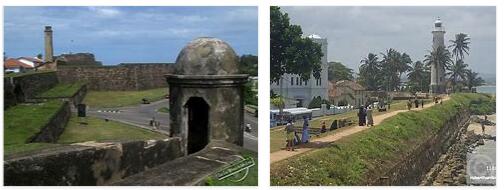Old Town and Fortress of Galle (World Heritage)

According to softwareleverage, Galles old town shows a mixture of European and South Asian architecture, which reflects the colonial history since the 16th century. Portuguese, Dutch and British left their mark here.
Galle Old Town and Fortress: Facts
| Official title: | Old town and fortifications of Galle |
| Cultural monument: | Mixture of European and South Asian architecture in the old town, which is enclosed by a 2.5 km long protective wall, among other things. with Groote Kerk, Queen’s House, New Oriental Hotel, Old Gate and Historical Mansion |
| Continent: | Asia |
| Country: | Sri Lanka |
| Location: | Galle, south of Colombo |
| Appointment: | 1988 |
| Meaning: | the best example of a fortified urban complex built by Europeans in South and Southeast Asia |
Galle Old Town and Fortress: History
| 1505 | Landing of the Portuguese |
| 1640 | after invasion with an armada of 12 ships and |
| 1663 | Fortress construction |
| around 1680 | Construction of the Historical Mansion |
| 1684 | Construction of the later New Oriental Hotel |
| 1701 | Construction of the bell tower |
| 1754 | Groote Kerk Foundation |
| 1796 | Takeover by English colonial associations |
| 1863 | Rededication of the garrison administration to the New Oriental Hotel |
| 1873 | Construction of the main gate |
| 1948 | Independence of Ceylon / Sri Lanka |
| 12/26/2004 | Severe destruction in the city and almost 4,000 dead from the tsunami of the Sumatra-Andaman quake |
A tropical spice port with a rooster in the coat of arms
The young Lourenço de Almeida, son of the Portuguese viceroy of India, was lucky that his ship, battered by the storm, did not run aground in November 1505 on the sandbanks and reefs on the coast of the island of Ceylon. Safe, even if battered, he escaped to a small, sheltered bay on the southwest coast, which the locals called “Gala”, the “rock”. The newcomers, however, associated the name “Gala” with the rooster, in Latin “Gallus”, and later immortalized these poultry in the coat of arms of the “United East India Company” and on the old gate at the harbor.
The nobleman from Portugal made the most of his predicament. He not only had his ship repaired and traded with the locals, but also visited the Sinhalese king who lived in Kotte. In view of his weak position in the country, the ruler was not averse to concluding a treaty with the representative of the then most powerful European sea power, which, in return for payment of spices and elephants, aimed to protect the country by the Portuguese. The gate to over 400 years of colonial rule was opened.
After the construction of a fortress in Colombo met open hostility from the Sinhalese population living there, the Portuguese initially settled for a rather modest trading post in Gala Bay. This port had a long history behind it, when the Portuguese sailors anchored here to fill their holds with cinnamon from the plantations in the hinterland. He was just as familiar with Arab dhows as he was with Chinese junks, because long before Vasco da Gama found the sea route to India in 1498, the peoples of South and Southeast Asia engaged in brisk maritime trade with one another.
The port city got its current colonial face under the Dutch, who conquered Galle on March 13, 1640 and three years later also dominated the lucrative cinnamon plantations. In Europe at that time, spices were high-priced luxury items that promised astronomical profit margins and were the real driving force behind the exploration of the sea routes to Asia.
The old town, also called fort, enclosed by a protective wall, extends far into the harbor bay on a rocky peninsula. A good dozen bastions were built into the wall for defense, but they have poetic names such as the Moon and Neptune bastions; An expression for the fact that there was probably no barrack-like atmosphere here, but rather the more tranquil everyday life of a small “tropical trading post”. In order to make life more bearable, the Dutch even installed a windmill on the Triton bastion, which pumped up seawater to wet the dusty paths. Of course, the “sewer specialists” from the North Sea also treated themselves to a well-functioning sewage system in order to counter the risk of epidemics. And that Protestantism held a protective hand over the small enclave of the Dutch way of life,
Flat houses with red tiled roofs, the glowing white mosque in the shape of a church, the deep blue sea and the palm trees swaying in the wind merge into a romantic image of a supposedly happy past. The fact that the Dutch felt quite comfortable under the tropical sun is testified by the many family ties to the local population, from which the fair-skinned Burgher emerged, who at times held a privileged position.
When the star of the Dutch began to fade on the oceans at the end of the 18th century, the British quickly stepped on the scene, who were now fighting with the French over the tropical benefice in South Asia. Without firing a shot, they occupied the island on February 16, 1796 and ruled it until Ceylon became independent. The main entrance gate to the north of the old town is the only outstanding feature of British presence; its origin is only through the coat of arms of King George III. to recognize.